I like this "haiku" or a short poem by Matsuo Basho.
Early in the afternoon, too hot far beyond my imagination, we toured around
Todaiji Temple, Nigatsudo Hall and Kasuga Grand Shrine.
Mr. Tsukuba, looked 60s, was a good guide. |
|
 |
|
| Severe-looking and a sour face at a glance. With an unchangeable countenance
he played on words at any key point. He knew when and how to pause quite
well and guided us energetically, not minding the dropping sweats. I really
thought he was the gift from Old Buddhas in Nara. |
|
| Nigatsudo Hall of Todaiji Temple |
|
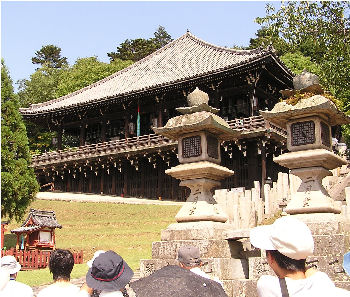 |
|
"Nigatsudo" means February Hall. Its name is because the festival
or "the rite of taking sacred water" has been in February of
the traditionl lunisolar calendar. Now it is held before dawn of March
13. Drinking the water here is said to cure illness.
They say spring comes after this festival. I have been enjoying the ceremony
on TV every year. |
|
"Do you want to go up to the 2nd floor?", Mr. Tsukuba asked us
solemnly.
I instinctively raised my hand with some others, and we enjoyed the inside
of Nigatsudo briefly. |
|
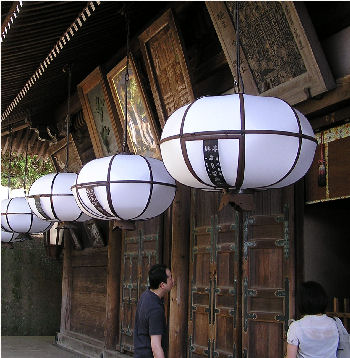 |
|
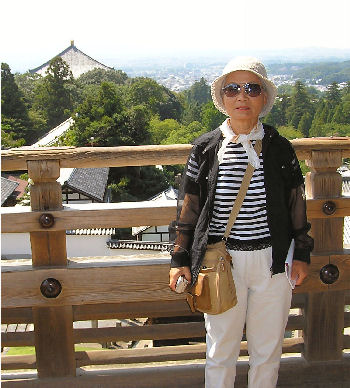 |
|
水とりや氷の僧の沓(くつ)の音
Mizutori ya Kouri no Souno Kutsu no Oto |
| Matsuo Basho |
|
|
| We only saw their outside about March Hall (Hokke-Do) and April Hall. Mr.
Tsukuba looked sorry. |
|
| Pictures at February Hall and the neighboring area |
|
| Todaiji Temple |
|
I was astonished at my weak memory. I didn't remember such a building,
though I might have visited here a couple of times including the school
trip in my junior high school days and the 3 days in Nara a few years ago.
The huge statue of Buddha and deers were in my memory all right, however,
the temple building itself was fresh in my eyes.
The present temple was rebuilt at the beginning of 18th century in Edo
period, the entrance of which was two third of the original one built by
Emperor Shomu in 8th century, Nara period. I may have heard the same explanation
before, too. |
|
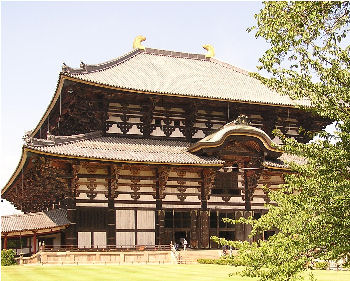 |
The Great Buddha of Todaiji
57.01 meters wide, 50.48 meters long, 48.74 meters high |
|
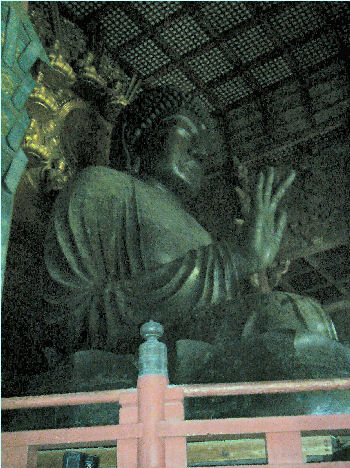 |
| Venerated image of Buddha |
height: 14.98 meters, head: 5.41 meters,
eye length: 1.02 meters, ear length: 2.54 meters,
pedestal height: 3.05 meters |
|
I strongly wished to come again to visit at least February Hall and Hokke-Do
Hall. I believed I would not feel tired even for a week then.
My romantic inspiration was stirred up by Mr. Tsukuba's explanation: the
history of Kegon School (Sect of Buddhism), the Great Buddha, the buildings
and the arts of National Treasure, Heijo Capital of Nara, etc. |
|
Pictures at Todaiji Temple and the neighboring area
1 2 |
|
| Kasuga Grand Shrine |
|
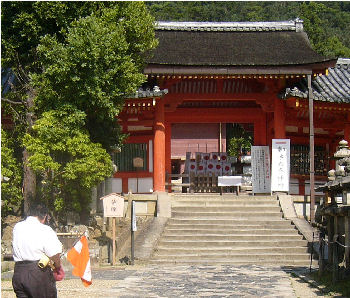 |
|
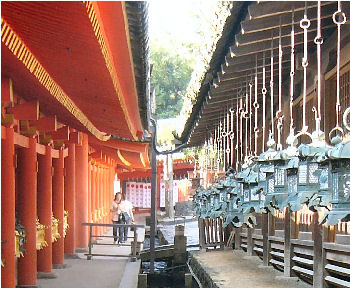 |
|
Kasuga Grand Shrine here is the chief of the Kasuga shrines scattered across
the country.
According to Wikipedia,
It is the shrine of the Fujiwara family, established in 768 AD and rebuilt
several times over the centuries. The interior is famous for its many bronze
lanterns, as well as the many stone lanterns that lead up the shrine.
Kasuga Shrine, and the Kasugayama Primeval Forest near it, are registered
as a UNESCO World Heritage Site as part of the "Historic Monuments
of Ancient Nara".
The path to Kasuga Shrine passes through Deer Park. In Deer Park, deers
are able to roam freely and are believed to be sacred messengers of the
Shinto gods that inhabit the shrine and surrounding mountainous terrain.
I was surprised at innumerable stone lanterns and hanging lanterns. They
say the total numbers are 3,000 or so. All of the lanterns are lit on the
day of Setsubun in February or the last day of winter according to the
old calendar, and on the special day in August. Just imagine what a gorgeous
sight!
|
|
Pictures at Kasuga Grand Shrine
and the surrounding area |
- - - - -
I listen to rakugo (commic storytelling) every night in bed as sleeping pills. I like the story "Shika Seidan" or "The Case of Deers". My favorite tellers of this story are Sanyutei Ensho and Katsura Beicho.
At the beginning of the story, both masters refer to the specialties of
Nara as follows.
| The Great Buddha of Todaiji, winding brushes of deer's hair, bleached cotton
of Nara, Kasuga lanterns and early birds in the town. |
The meaning hidden in "Kasuga lanterns" is that they are too many to count.
And the meaning hidden in "early birds in the town" is very serious.
In Edo period or before, deers around the shrine were sacred messengers
of the Shinto gods. Therefore to kill a deer, in any cause, was a crime
that deserved the death penalty. As nobody wanted to find a killed deer
in front of his house, he had to get up early to check any such dead body
around his house. He had to be an early bird.
The rakugo "Shika Seidan" begins its story with the happening
that a man of tofu making killed a deer by accident. |
|
|